Dairy cooperatives, once touted as the instrument of socioeconomic change, are on the verge of collapse. It is high time for dairy extension professionals to work expressly towards strengthening dairy cooperatives through increased cooperation and participation of members in dairy cooperative activities, and development of leadership for efficient management of cooperatives, argues Dr SVN Rao.
CONTEXT
The dairy cooperatives in India helped in improving the socioeconomic status of dairy farmers, and made possible the supply of processed milk and milk products to consumers at reasonable prices. The three-tier structure of dairy cooperatives, the so-called Anand Pattern, evolved through a lot of effort and investment by the National Dairy Development Board (NDDB) under the dynamic leadership of the late Dr Verghese Kurien. By 2016-17, there were about 177,000 dairy cooperative societies, with a cumulative membership of 16.3 million milk producers (NDDB Annual Report 2016-17). But, with the recent introduction and promotion of New Generation Cooperatives, dairies are functioning under different modes, viz., Dairy Cooperative Unions, Mutually Aided Cooperative Unions, Milk Producer Companies, and private companies with varying degrees of success. It appears that milk unions are moving in the direction of getting privatised and in the process the basic purpose of dairy cooperatives in protecting the interests of both producers and consumers may be lost. Case studies of some of the milk unions in southern India are pointing to this trend. Thanks to political rivalry, even in Gujarat, the birth place of the dairy cooperative movement in India, chinks started appearing in the armour of Gujarat Co-operative Milk Marketing Federation after 46 years of operation.
DAIRY COOPERATIVE MOVEMENT IN INDIA
The foundation of dairy cooperatives was firmly laid in the state of Gujarat, which is a dominant player in the marketing of various milk and milk products under the brand name ‘AMUL’. With the success achieved by AMUL, the Anand Pattern of milk cooperatives were replicated in almost all the states, which ushered in the ‘white revolution’ in the country (Box 1). With globalisation and increased threat from private dairies, the Government of India – based on the recommendations of the committee headed by D. YK Alagh – brought in the Companies (Amendment) Act 2002. This formed the basis for the evolution of New Generation Cooperatives (NGCs) in India (see Box 2). The NDDB which played a key role in forming and nurturing dairy cooperatives is encouraging the formation of NGCs, which ultimately may result in converting the milk unions into milk producer companies. Although the objective is to set up producer companies in areas where cooperatives are not present, the strong unions in Andhra Pradesh have got them registered as producer companies.
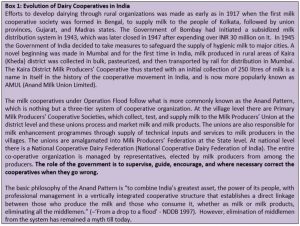 MAJOR FLAWS IN DAIRY COOPERATIVES IN INDIA
MAJOR FLAWS IN DAIRY COOPERATIVES IN INDIA
Rao et al. (2009) gave a detailed account of how milk producers are being exploited by all the stakeholders in dairy development in India. Some of the important issues pertaining to dairy cooperatives as analysed by them are presented below:
-
Government control and interference:
The state Governments either directly or indirectly control the price of milk (considered as an essential commodity) and the milk producers have absolutely no say in this. Bhasin (2004) opined that the role of government and the Registrar of Cooperative Societies has not been positive, and there is a tendency to control the cooperatives and interfere in their working. At some places a government/private sector nexus has developed to the detriment of the cooperatives. In fact, while delivering the inaugural address at the 34th Dairy Industry Conference held at Bengaluru, Montek Singh Ahluwalia (2005), stated “There is a perception in the country that the cooperative form of organization has got weakened and it needs to be freed from the intrusive control of the government”.
-
Monopoly of DCSs:
Although dairy farmers have an option to sell milk to different agencies, most of them in rural areas have no option but to supply to dairy cooperatives (Holt and Ramkumar 2003). Theoretically, milk cooperatives serve as an excellent intervention for milk producers to get remunerative prices for their milk. But in practice many societies/unions in some parts of the country are running under severe losses for a variety of reasons. Irrespective of the reason, the milk producer has to pay for these losses. It is sad that the producers have to pay the cost for malpractices in collection of sample milk, weighing and testing, delay in payments, supply of poor quality inputs like cattle feed, etc. This is the reason why dairy cooperatives are branded as ‘Organised middlemen’ or ‘Cooperative middlemen’.
-
Farmers have no say:
Rajivlochan (2008) argued that no one asks farmers for their opinion/inputs while conceiving several schemes for their development. The policy makers assume that they are well aware of the needs of the farmers without properly understanding the ground realities and the net result is that these schemes abort in the initial stages itself forcing the policy makers to evolve new schemes without learning any lessons from the previous experience. If the government is serious about achieving pro-poor economic growth it is necessary that these resource-poor milk producers are involved right from the start of any dairy development intervention – by allocating resources to identifying their problems, targeting these and planning appropriate interventions in partnership with them (Peacock et al. 2005).
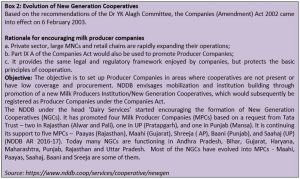 Despite all these lacunae, most of the dairy cooperatives are able to provide a stable milk procurement price for the farmers compared to other livestock products, such as chicken, meat, eggs, etc., the prices of which fluctuate.
Despite all these lacunae, most of the dairy cooperatives are able to provide a stable milk procurement price for the farmers compared to other livestock products, such as chicken, meat, eggs, etc., the prices of which fluctuate.
The International Cooperative Alliance (ICA) has laid down the following principles/guidelines for cooperatives in order to put their values into practice. These include:
- Voluntary and Open Membership;
- Democratic Member Control;
- Member Economic Participation;
- Autonomy and Independence;
- Education, Training and Information;
- Cooperation among Cooperatives; and
- Concern for Community.
ICA firmly believes that “If all these principles are observed and applied in the day-to-day operations of a co-operative enterprise, that co-operative enterprise will be stronger and more sustainable”. But unfortunately, these principles are breached in one way or another as far as dairy cooperatives are concerned, thus threatening the sustainability of the cooperative system itself. Some examples are presented here along with the experiences gathered from the dairy cooperatives in southern India.
In southern India, there are five states, and each one (except Telangana) is having a Milk Federation. The Union Territory, Puducherry, has a Milk Union. Based on secondary data, cases of one successful milk federation, two successful milk producer companies, and two failed milk unions are analysed and presented below.
-
Karnataka Cooperative Milk Producers’ Federation Limited (KMF)
KMF is the second largest dairy co-operative (after AMUL) among the dairy cooperatives in the country. It sells its milk and milk products under the brand name ‘Nandini’. KMF has 14 Milk Unions covering all the districts of Karnataka State, which procure milk from more than 14,000 Primary Dairy Cooperative Societies covering more than 22,000 villages in the state.
The AMUL Pattern dairy co-operatives started functioning in Karnataka from 1974-75 with financial assistance from the World Bank/IDA, Operation Flood II & III. The Anand Pattern’s three-tier organisational structure – Dairy Cooperative Societies (DCSs) at the village level, District Milk Unions at the district level, and a Federation at the state level – is resolutely and harmoniously working hand-in-hand in creating a self-sustaining rural economy based on cooperative dairying. All these three are governed by a democratically elected board from among the milk producers. Under the direction of elected boards, KMF, and various functional Units & Unions are performing the assigned tasks to ensure fulfilment of the organisation’s objectives. KMF is one of the few federations in the country that have converted dairying from a subsidiary occupation into an industry. Coordination of activities among the Unions and developing markets for milk and milk products is the responsibility of KMF. Marketing milk in the respective jurisdictions is organized by the respective Milk Unions. Surplus/deficit of liquid milk among the member Milk Unions is monitored by the Federation. While the marketing of all the milk products is organized by KMF, both within and outside the State, all the milk and milk products are sold under a common brand name – NANDINI.
Coordination of activities among the Unions and developing markets for milk and milk products is the responsibility of KMF. Marketing milk in the respective jurisdictions is organized by the respective Milk Unions. Surplus/deficit of liquid milk among the member Milk Unions is monitored by the Federation. While the marketing of all the milk products is organized by KMF, both within and outside the State, all the milk and milk products are sold under a common brand name – NANDINI.
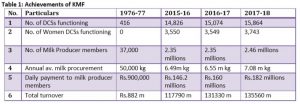 The Federation is largely successful in realizing the objectives of dairying during the last four decades of dairy development in Karnataka State. The success of KMF is attributed to its efficient and timely input services delivered to farmers at their door-steps. It is providing quality veterinary health services and AI to any remote village, makes up shortfall in cattle feed at less than the market price, and offers very good procurement prices. This has, therefore, attracted greater patronage from farmers for these cooperatives. The extent of patronization by farmers is so complete that the dominant share of marketable surplus milk of farmers in Karnataka is procured by KMF dairies, and there is hardly any organized private dairy milk procurement, which is widely prevalent in other parts of the country. In addition, KMF was able to exploit the huge ghee market of Tirumala Tirupati Devastanam (TTD) for preparing about 250,000 laddus (sweets) daily. It supplied ghee, around 10,000 kg/day to TTD for about two decades up to 2015. Again after a lapse of four years, this year KMF has regained this ghee contract.
The Federation is largely successful in realizing the objectives of dairying during the last four decades of dairy development in Karnataka State. The success of KMF is attributed to its efficient and timely input services delivered to farmers at their door-steps. It is providing quality veterinary health services and AI to any remote village, makes up shortfall in cattle feed at less than the market price, and offers very good procurement prices. This has, therefore, attracted greater patronage from farmers for these cooperatives. The extent of patronization by farmers is so complete that the dominant share of marketable surplus milk of farmers in Karnataka is procured by KMF dairies, and there is hardly any organized private dairy milk procurement, which is widely prevalent in other parts of the country. In addition, KMF was able to exploit the huge ghee market of Tirumala Tirupati Devastanam (TTD) for preparing about 250,000 laddus (sweets) daily. It supplied ghee, around 10,000 kg/day to TTD for about two decades up to 2015. Again after a lapse of four years, this year KMF has regained this ghee contract.
This is a remarkable case where, by and large, the cooperative principles have been adhered to with minimum interference and good patronage from the Government of Karnataka for almost 45 years, and this growth and development is likely to be sustained in the years to come.
-
Pondicherry Milk Producers’ Cooperative Union Limited (PMPCU Ltd.)
PMPCU Ltd. was the first cooperative society registered in the year 1955 in the Union Territory of Puducherry. In 1973 it was converted into the Milk Producers’ Union and now it has 98 functional village level milk producers’ cooperative societies. It has a small dairy with a capacity to handle about 120,000 litres per day.
PMPCU was one of the best till 2004 and was running successfully in Puducherry. Payments were made to member producers once in a fortnight, regularly, and they used to regard the Union as a bank to depend up on. At the end of a fortnight, the lump sum amount they received for the milk they poured into the societies was handy to meet expenses such as payment of school fees, purchase of provisions, clothes, purchase of cattle feed, etc. Almost the entire milk required – about 60,000 litres per day – was procured only through village level societies. The processed milk and milk products were sold to urban consumers at a reasonable price. The Union was the envy of the neighbouring states.
This situation changed in 2002 when the Board of Management of the Union was dissolved by an order of the High Court, Chennai, on charges of large scale corruption. The elections to the Board of Directors were last held in 2002. Since then a government official from the Dept. of Cooperatives is acting as Administrator. Since 2004-05 as the Union is not able to procure the required quantity of milk to meet the demand for milk and milk products, the Union started procuring milk from other dairies, both cooperative and private. By 2011-12 the average daily procurement from private dairies reached 73,400 litres per day whereas the procurement from its societies was 29,500 litres per day. Since 2006-07 the Union started incurring losses. The cumulative losses have gone up from INR 2.6 million in 2006-07 to INR 9.97 million in 2010-11.
These losses were attributed to government interference in managing the affairs of the Union. Succumbing to political pressure the Union appointed 275 casual workers in 2004-05. As on today the total employees in the Union is 788, very high compared to the 1,20,000 litres of milk handled per day. Although it is running at a loss, the employees have been given benefits – one litre of milk per day and 0.5 kg ghee per month to all. The Union never recovered after 2004. The milk producers have been losing interest in rearing cattle in Puducherry and the number of cattle owners as well as the average herd size is showing a declining trend. This is a case where some of the principles of cooperatives were violated leading to poor performance of the Union. These principles are: i) Democratic member control; ii) Member economic participation; iii) Autonomy and independence; and iv) Concern for community.
The government (Registrar, Cooperatives) has not taken interest in conducting elections to the Milk Producers Cooperative Societies and the whole show is run by the secretaries of the societies and government officials. For all practical purposes it is a government-administered union with no participation or control of its members. It is unlikely that PMPCSU Ltd. will come out of the red and its future depends greatly upon the extent of support it gets from the Government of Puducherry.
-
Andhra Pradesh Dairy Development Cooperative Federation Ltd. (APDDCF)
The APDDCF started functioning in 1981. Prior to this it was known as AP Dairy Development Corporation. This federation is operating 15 dairy plants in the state. Three milk unions (Krishna, Guntur, and Karimnagar) converted themselves into Mutually Aided Cooperative Unions Ltd, a hybrid between cooperatives and private companies. One Milk Union totally metamorphosed into a company (Vijaya Visakha Milk Producers’ Company Limited). At present the Milk Unions are facing stiff competition from private dairies.
3.1. The fall of Chittoor Cooperative Dairy
Chittoor in Andhra Pradesh was considered to be the second largest milk producing district in India after Anand in Gujarat. The people of this district depend primarily on sericulture and dairy farming for their livelihoods. Over the years due to declining land size and acute drought conditions, farmers, especially the small, marginal and landless agricultural labour, were thriving on dairy farming. The Chittoor Cooperative Milk Producers’ Union established a dairy in 1969 with a handling capacity of 6,000 litres per day. By 1989-90 it had attained a capacity of 250,000 litres per day. Its downfall started when it could not sell the huge quantity of milk powder processed from the surplus milk. It could neither pay the milk producers nor recover from its losses, ultimately leading to its closure in 2002.
At this juncture the Government of Andhra Pradesh sought intervention from the National Dairy Development Board (NDDB). The NDDB with assistance from the state government established another private dairy -The Balaji Dairy in 2005. This situation was congenial for many private dairies to come up and they started exploiting the milk producers through low milk procurement prices and irregular payments for the milk supplied. Furthermore, they did not provide any technical input services to them. The dairies in this district had increased their supply to such an extent that they were supplying milk in rail wagons to Mother Dairy, New Delhi.
Taking advantage of the government’s policy, Heritage Foods Limited was established in 1991. Its market presence is felt in 15 states/UTs of India. There were reports that Heritage Dairy virtually made the Chittoor Dairy defunct, which was once famous for its cheese products and a notable success under the cooperative sector. Efforts were neither made to revive the Chittoor Dairy nor payments made to its employees and member producers. Till date efforts have not been made to either revive the Chittoor Dairy or settle the payments of its ex-employees. This is another case where the principles of cooperatives were violated. The dairy was unable to face stiff competition from the private dairies, or get the timely support it deserved from the state government to revive.
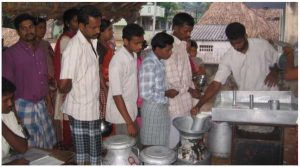
3.2. Krishna District Milk Producers’ Mutually Aided Cooperative Union Ltd.
Krishna district of Andhra Pradesh has a rich heritage, one of the important factors which contributed to the Union’s success. Cattle rearing is an important occupation for the farmers in this district. In fact it has been a part of the people’s culture since ages. Based on the recommendation of a UNICEF High Level Committee, four chilling centres in different parts of the district, and a milk products factory with one lakh litres handling capacity per day, were established in Vijayawada by the Department of Animal Husbandry, Govt. of Andhra Pradesh in 1960.
The milk product factory started milk procurement with a modest collection of 243 litres per day in 1965. The Krishna District Milk Producers’ Co-operative Union Ltd. was established in 1965, and it was converted into the Krishna District Milk Producers’ Mutually Aided Co-operative Union Ltd. in 1995 under the Andhra Pradesh Mutually Aided Cooperative Society Act 1995. (See Box 2 on rationale for New Generation Cooperatives.)
By the year 2017-18, the turnover of business has reached INR 6620 million with daily average milk procurement of 154,000 litres per day. The daily milk sales average per day has reached up to 271,000 litres. It has obtained ISO 9001:2015 and ISO 22000:2005, and FSSAI Certificates.
The milk union is earning profits and distributing the price differential amount to its members regularly. It is paying about INR 632 million to farmers as cost of milk procured from them. In a way it has strengthened the rural economy by avoiding middlemen and making available safe milk and milk products to consumers. The societies in rural areas are providing funds for roads, schools, community, buildings, veterinary hospitals, libraries and so on.
The success of the Krishna Milk Union is attributed to its adherence to the principles of cooperatives which include autonomy and independence, democratic control and concern for community. This Union is now an autonomous body with least government control. The member producers derive pride in being members of the milk cooperative societies of the Union. The Union is able to pay remunerative prices to member producers regularly, and supply quality milk and milk products to consumers. In addition, credit has to be given to the farmers who consider rearing cattle as an important livelihood activity and it has become an integral part of their culture. Above all, the dynamic leadership provided by Shri Mandava Janakiramaiah who has been successful in commanding the respect of the member producers as the Chairman of the Union since 1995.
3.3. Sri Vijaya Visakha Milk Producers’ Company Limited (Visakha Dairy)
Visakha Dairy was established in 1973 under the Cooperative Societies Act and in 1977 it commissioned a dairy plant at Visakhapatnam with 50,000 litres per day handling capacity.
With introduction of the MACS Act in 1995 by the AP State Government, Visakha Dairy was converted under the said Act in 1999 and registered as ‘Sri Vijaya Visakha District Milk Producers Mutually Aided Cooperative Union Ltd’. To fulfil its growth aspirations while retaining the cooperative ideology as core principles of governance, Visakha Dairy converted into a producer company in 2006 under the name of ‘Sri Vijaya Visakha Milk Producers Company Limited’. This became possible given the initiative taken by the Government of India to enable cooperatives to grow and operate on a competitive platform. The Companies (Amendment) Act 2002 was introduced, enabling a cooperative form of enterprises known as producer companies that can be registered under Part IX A of the Companies Act 1956. The evolution of Vijaya Visakha Milk Producers’ Company Ltd. is clearly linked to the political compulsions prevailing at that time (see Sulaiman et al. 2011).
Visakha Dairy is one of the fastest growing milk and milk products manufacturing company having two plants in Andhra Pradesh. Both the plants are equipped with state of the art technology and are ISO 22000:2005 certified. Presently both the plants have the capacity to handle up to nine lakh litres per day. It manufactures different varieties of milk and milk products and sells in Andhra Pradesh and neighbouring states of Telangana, Odisha and Chhattisgarh. The company has crossed turnover of INR 1000 crore. The company is fast moving in the direction of improving its growth as well as farmers’ welfare.
A milk powder plant with a capacity of 13 metric tons per day was constructed in 1998 to convert surplus milk into skimmed milk powder in the flush season. Similarly, in 2001 an aseptic packing station was set up with a capacity of 30,000 litres per day for UHT milk production and expanded to 3 lakh litres per day capacity in 2015. It is to its credit that Visakha Dairy enjoys a 10% market share in UHT milk on a pan-India basis.
The company was successful in creating a very good infrastructure for the benefit of its member producers. It has established a Training Centre and imparts training to farmers in all aspects of dairy farming, including clean milk production. It has also established 633 Veterinary Health Centres for providing healthcare to animals of its members at 50% subsidy. In addition seven Mobile Veterinary Service Vehicles are operating to provide healthcare to dairy cattle spread across more than 25 villages every day. It has established cattle feed plants with more than 400 MT per day of feed capacity and supplying cattle feed to farmers at subsidized rates. Furthermore, it has constructed more than 100 Bulk Milk Cooling Centres to procure and cool the milk covering every 10 km radius. Together the bulk coolers have a total capacity of 906,000 litres and are automated.
Visakha Dairy through its Milk Producers’ Educational Health and Medical Welfare Trust is extending medical services to farmers and their families at subsidised rates at the 400- bed modern hospital constructed with 70 crores investment. Apart from all this it offers education to the farmers’ children, preference to producers’ children in employment, irrigation projects, culverts, kalyana mandapams, bridges, canals, etc. It provides employment to more than 2000 employees, including contract labour.
Visakha Dairy is one of the successful dairies in the country and this could be attributed to the complete autonomy it enjoys. It is growing consistently and paying remunerative procurement price to milk producers, and supplies quality milk and milk products to consumers. It has a benevolent concern for the community because of which it provides various welfare measures for the benefit of the milk producers. Another important reason for its success is that its Chairman, Shri Adari Tulasi Rao, has been providing the vital dynamic leadership to this company for more than three decades. He is seen as the ‘Vizag Kurien’ by the members of the milk producers of all three districts of Andhra Pradesh.
Based on the case study of Visakha Dairy, Sulaiman et al. (2011), identified three decisive reasons for the successful evolution and growth of Visakha Dairy. These include: i) its extensive networks in political, bureaucratic, and civil society circles; ii) its wide-ranging support to producers – including educational and medical support; and iii) its commitment to consumers in terms of quality, pricing and availability. They concluded that these ‘institutions’ (patterns of behaviour) facilitated Visakha Dairy in accessing, sharing and applying tacit knowledge to compete, expand, and flourish.
The future of these two dairies (Krishna and Visakha) depends upon the extent to which the incumbent leaders (the chairmen) remain at the helm of affairs of the Unions, or equally competent leaders take over the reins of the Unions, subject to the prevailing socio-political environment. How long they will continue to enjoy the trust and confidence of its members is a million dollar question. Lately some reports say that everything is not going well with respect to financial management at Visakha Dairy.

LESSONS
One of the major lessons that emerge from the analysis of these cases is that milk cooperatives will be successful in realising their objectives provided there is: i) no interference from the government; ii) dynamic leadership; iii) less competition from the private sector; and iv) clear adherence to the cooperative principles. With continued support from the government to provide autonomy to milk unions/dairies, it is likely that milk unions may follow the path of Visakha Dairy which is doing well in Andhra Pradesh. But the sustainability of such dairies in providing service to society is doubtful as, finally, it all depends upon the wisdom/ability of its leaders and their political affiliations.
Here, it is worth quoting the observations of ICA regarding the functioning of cooperatives. ICA noted that “Some governments that used co-operatives as government controlled engines of economic development made membership of co-operatives compulsory. This too breaches the 1st Principle. The right of (a) voluntary association to form co-operatives can also be frustrated by national legislative, tax and administrative systems which favour the investor owned model of business enterprise and do not take account of the specific nature of co-operative enterprise, hence the importance of co-operatives working politically to influence the legal, financial and administrative regimes in which their business enterprises operate”.
Based on a comparative analysis of cooperatives in four European countries, Birchal (2009), argued that “It is that co-operatives are not just for the poor; some of the richest countries in the world depend heavily for their success on co-operative businesses. Neither are co-operatives for the rich; in these successful countries it is the small business-people, the farmers and the low to middle income consumers who benefit most from co-operative membership. Unlike other forms of business, co-ops both generate wealth and spread it around more equally. In the midst of a recession caused by a banking crisis fuelled by short-termism, self-seeking and greed, this must be a hopeful message. If we want to strengthen the Scottish economy, and help it to ride out the world recession, one way to begin would be by maximising the potential of the cooperative type of business”. India is no exception to this.
These revelations indicate the need to reaffirm faith in cooperatives in the larger interests of the nation. Institutions, such as NDDB, need to invest in protecting and nurturing these producer-friendly institutions as was done in the past. Equally important is to make the operations of dairy cooperatives transparent so as to reinforce the confidence of its member producers.
IMPLICATIONS FOR DAIRY EXTENSION PROFESSIONALS
It is high time that dairy extension professionals start working for strengthening the dairy cooperatives through increased cooperation and participation of members in dairy cooperative activities, and in development of leadership for efficient management of cooperatives.
Extension must play a vital role in protecting the interests of milk producers, who happen to be their major clientele. A good majority of member producers do not realise that they own dairy cooperatives and do not involve in the activities of dairy cooperative societies. The extension professionals must work towards strengthening dairy cooperatives by educating and encouraging members in order to ensure their active ‘cooperation and participation’ in the activities of dairy cooperatives.
Extension professionals can also help in identifying, training, and developing cooperative leadership so as to enable the leaders to efficiently manage the activities of dairy cooperatives.
It is also necessary for them to conduct comprehensive research on differential performance of milk unions under different modes of management, viz., Dairy Cooperatives, Aided Cooperative Cooperatives, Producer Companies and Private Companies. The results will help in guiding the government in formulating appropriate policies to protect the interests of millions of our milk producers whose livelihoods depend upon dairy farming.
References
Bhasin NR. 2004. Dairy vision 2020 Opportunities & Challenges. Indian Dairyman 56(10).
Chittoor Cooperative Dairy http://shodhganga.inflibnet.ac.in/bitstream/10603/102654/9/09_chapter%203.pdf Accessed on 2 February 2019.
Birchall Johnston. 2009. A comparative analysis of cooperative sectors in Scotland, Finland, Switzerland and Sweden. Cooperative Development Scotland https://institute.coop/sites/default/files/resources/094%202009_Birchall_A%20comparative%20analysis%20of%20cooperative%20sectors%20in%20Scotland,%20Finland,%20Sweden,%20and%20Switzerland.pdf. Accessed on 19 May 2019.
Holt G and Ramkumar S. 2003. Diversity, competition and complementarity of milk marketing systems in rural and peri-urban locations. The 2003 International Sustainable Development Research Conference Proceedings. Nottingham: Nottingham University.
International Cooperative Alliance. Guidance notes to the cooperative principles. 2015 https://www.ica.coop/sites/default/files/publication-files/ica-guidance-notes-en-310629900.pdf. Accessed on 2 February 2019.
Krishna District Milk Producers Mutually Aided Cooperative Union Ltd. http://www.kmuvja.com/about-us.php Accessed on 2 February 2019.
Karnataka Cooperative Milk Producers Federation Ltd. https://www.kmfnandini.coop/ Accessed on 2 February 2019.
Montek Singh A. 2005. Inaugural Address. 34th Dairy Industry Conference, Bengaluru. Indian Dairyman 57(12):15-18.
National Dairy Development Board. 2017. Annual Report 2016-17.
Peacock C, Devendra C, Kitalyi A and Best J. 2005. Lessons learned and the way ahead. P. 527 in Livestock and wealth creation – Improving the husbandry of animals kept by resource poor people in developing countries (Owen E, Kitalyi A, Jayasurya N and Smith T, eds.). Nottingham: Nottingham University Press.
Pondicherry Cooperative Milk Producers’ Union Ltd. https://cooperative.py.gov.in/node/164
Accessed on 10 February 2019.
Rajivlochan M. 2008. No one asks the farmer. The Indian Express, Open page, 16 January 2008.
Rao SVN, Natchimuthu K and Ramkumar S. 2009. Milk producers pay for all. Indian Dairyman July 2009: 61-66.
Sulaiman RV, Laxmi Thummuru, Andy Hall and Jeroen Dijkman. 2011. Tacit knowledge and innovation capacity: Evidence from the Indian livestock sector. Knowledge Management for Development Journal 7(1):32-44.
Sri Vijaya Visakha Milk Producers Company Ltd. http://www.visakhadairy.com/ Accessed on 2 February 2019.

Dr S V N Rao retired as Professor and Head, Department of Veterinary and Animal Husbandry Extension Education, Rajiv Gandhi Institute of Veterinary Education and Research, Puducherry. (svnrao1953@gmail.com)



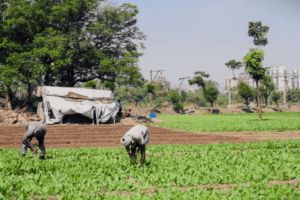

Add Comment